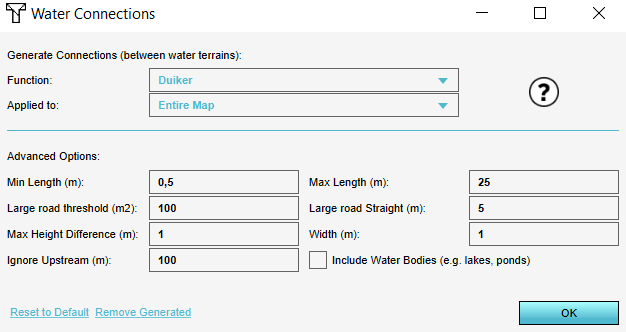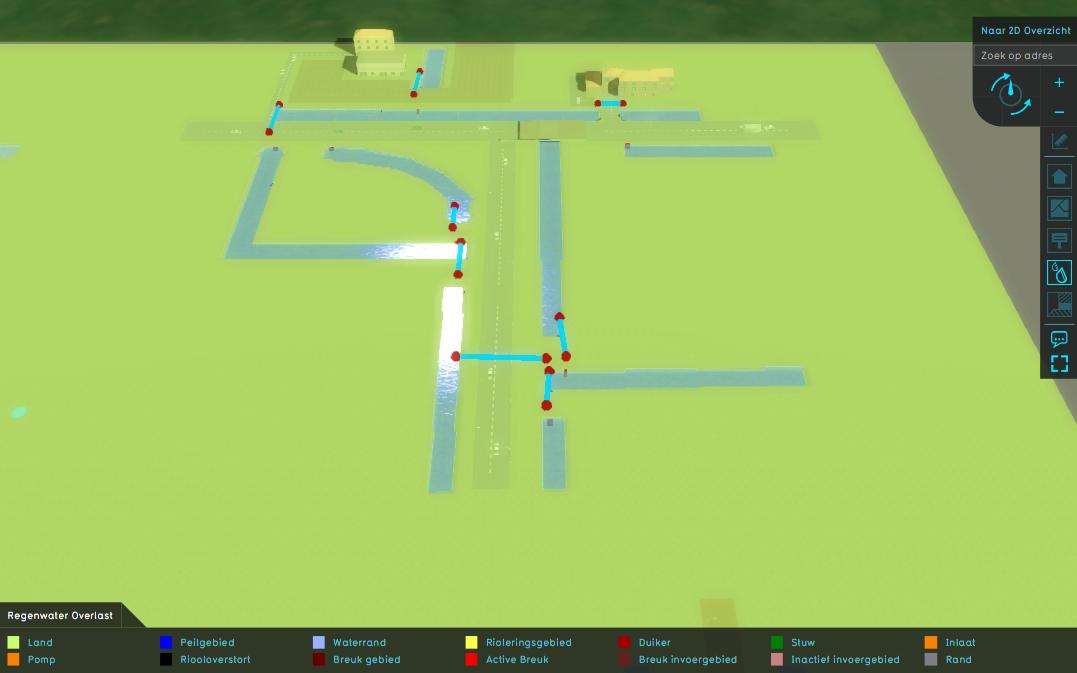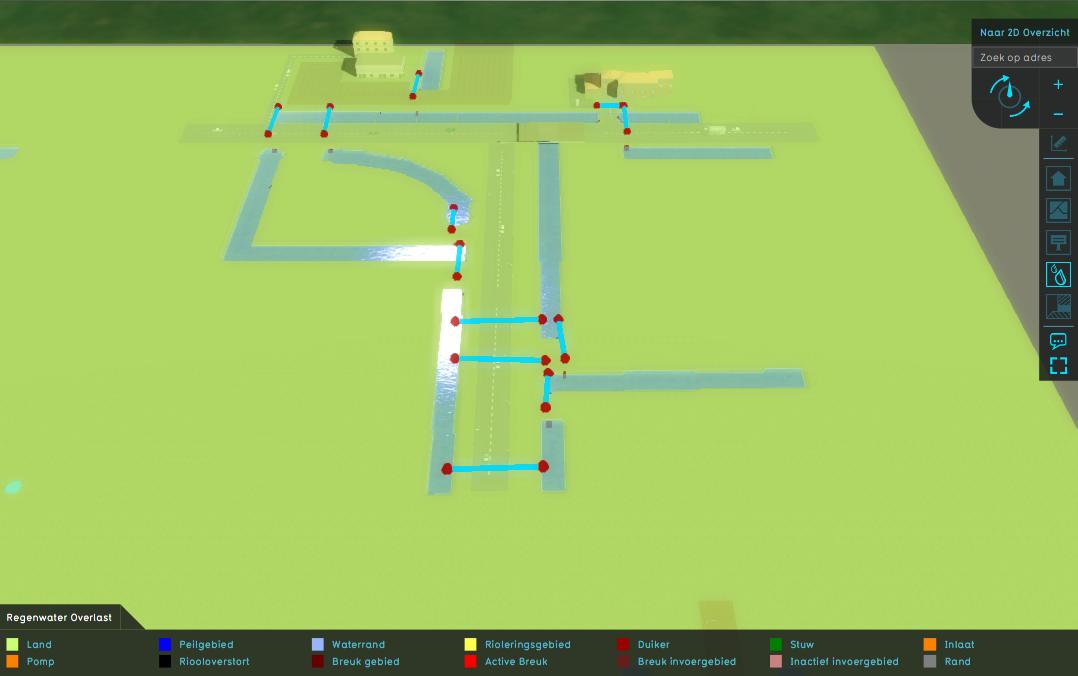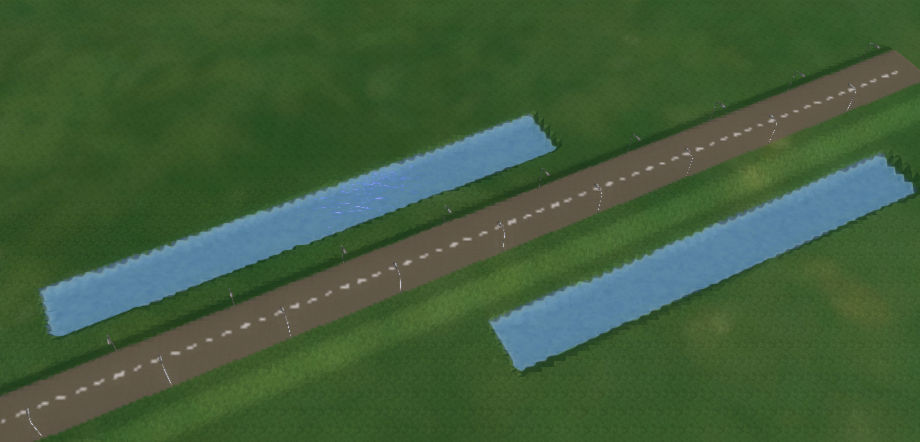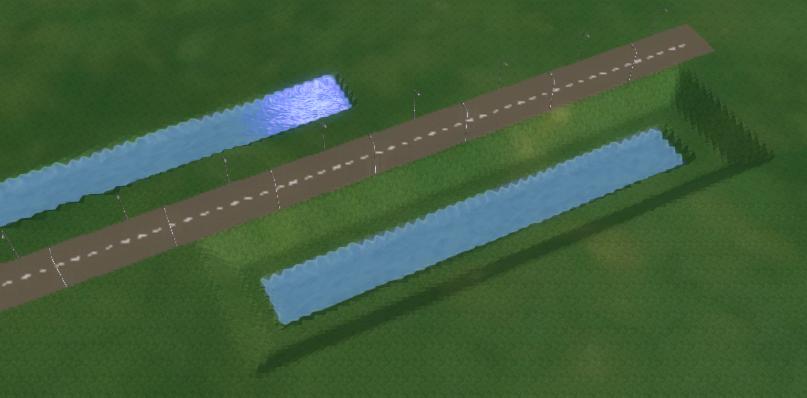Water Connection Generator: Difference between revisions
No edit summary |
No edit summary |
||
| Line 1: | Line 1: | ||
The Water Connection Generator enables users to generate (and remove) underground [[buildings]] such as [[ | The Water Connection Generator enables users to generate (and remove) underground [[buildings]] such as [[Culvert_(Water_Overlay)|culverts]] using a set of parameters. This generator can be used for example when creating a project with the [[Water Overlay]], but a dataset with all culverts is not available. | ||
The parameters are explained below under [[#Advanced Options|Advanced Options]]. | The parameters are explained below under [[#Advanced Options|Advanced Options]]. | ||
[[File:Water_connection_generator.PNG|The Water Connection Generator panel]] | [[File:Water_connection_generator.PNG|The Water Connection Generator panel]] | ||
==Function selection== | |||
==Advanced Options== | ==Advanced Options== | ||
===Mininimum and maximum length=== | ===Mininimum and maximum length=== | ||
Both the minimum and maximum length can be provided to limit the amount of created | Both the minimum and maximum length in meters can be provided to set the length of the created water connections and to limit the amount of created connections. The length is measured as the closest points between two water bodies. | ||
===Large road threshold=== | ===Large road threshold=== | ||
A road is considered large (and | A road is considered large (and therefore impassable by a water connection) when the road's size is larger than the set threshold value. This parameter can be used to prevent water connections crossing large roads. The large road threshold is provided as a surface size in m2. The surface size of each road polygon is then checked against the threshold value. | ||
=== Large road straight=== | === Large road straight=== | ||
The large road straight is used to measure if waterways are perpendicular | The large road straight parameter is used to measure if waterways are perpendicular to each other. It is measured by extending the placed water connection by x meters and if it is still in a waterway or body, then it is perpendicular and accepted. For parallel waterways, this check will not create a water connection when the defined x is sufficiently large. | ||
<ul> | <ul> | ||
<li style = "display:inline-block">[[File:large_straight.jpeg|400px|thumb|Culverts generated with a | <li style = "display:inline-block">[[File:large_straight.jpeg|400px|thumb|Culverts generated with a 30 meter large road straight setting. Notice that in the case of the waterways separated by large roads, culverts are only generated when a waterway is perpendicular to each other.]]</li> | ||
<li style = "display:inline-block">[[File:small_straight.jpeg|400px|thumb|Culverts generated with a less restrictive, 5 meter large road straight setting.]]</li> | <li style = "display:inline-block">[[File:small_straight.jpeg|400px|thumb|Culverts generated with a less restrictive, 5 meter large road straight setting.]]</li> | ||
</ul> | </ul> | ||
=== Maximum height difference === | === Maximum height difference === | ||
The height | The maximum height difference in meters that is allowed for the water connection te be generated. The height difference is measured on the surface where the water connection would be. This parameter can therefore be used to detect levees on the surface and prevent water connections through them. Additionally, this same parameter can be used to prevent connections being created for water ways that have very different water levels. | ||
<ul> | <ul> | ||
<li style = "display:inline-block">[[File:water_connection_max_height.jpg|400px|thumb|Two waterways with a levee | <li style = "display:inline-block">[[File:water_connection_max_height.jpg|400px|thumb|Two waterways with a levee inbetween. A stricter max height difference can prevent the creation of an unrealistic water connection.]]</li> | ||
<li style = "display:inline-block">[[File:water_connection_height_difference.jpeg|400px|thumb|Two waterways, of which one is situated 5 meters lower than the other.]]</li> | <li style = "display:inline-block">[[File:water_connection_height_difference.jpeg|400px|thumb|Two waterways, of which one is situated 5 meters lower than the other, where there typically would be no water connection.]]</li> | ||
</ul> | </ul> | ||
=== Width === | === Width === | ||
The construction will have its width set to this value when | The generated water construction will have its width set to this value when generated. The width is provided in meters. For [[Culvert_(Water_Overlay)|culverts]], the width will be the [[Culvert_diameter_(Water_Overlay)|culvert diameter]]. | ||
=== Ignore upstream === | === Ignore upstream === | ||
Sometimes multiple water connections can be created for the same water bodies. The parameter | Sometimes multiple water connections can be created for the same water bodies. The ignore upstream parameter can be used to remove connections of which its end point differ by more than the indicated amount in meters. It is somewhat similar to the parameter '''Maximum height difference''', but more restrictive in its application. | ||
It is somewhat similar to the parameter '''Maximum height difference''', but more restrictive in its application. | |||
=== Include water bodies === | === Include water bodies === | ||
When selected, both [[waterways]] and [[water bodies]] are taken into account as water terrains. When not selected, only waterways are taken into account. | When selected, both [[Terrain_Type#Surface|waterways]] and [[Terrain_Type#Surface|water bodies]] are taken into account as water terrains where water connections to and from are generated. When not selected, only [[Terrain_Type#Surface|waterways]] are taken into account. | ||
==Optional actions== | |||
* The '''Reset to defaults''' action reverts the values of the advanced options back to the default settings. | * The '''Reset to defaults''' action reverts the values of the advanced options back to the default settings. | ||
* The '''Remove generated''' action removes all generated constructions of the | * The '''Remove generated''' action removes all generated constructions of the selected function. Note that this also removes not generated constructions of this function. For example constructions which were imported or manually drawn. | ||
===See also=== | ===See also=== | ||
[[File:YoutubeLogo1.jpg|thumb|left|link=https://youtu.be/Ac2yAKAh9aY|Editing the Water Connection Generator (Dutch Only)]] | [[File:YoutubeLogo1.jpg|thumb|left|link=https://youtu.be/Ac2yAKAh9aY|Editing the Water Connection Generator (Dutch Only)]] | ||
Revision as of 10:15, 31 August 2020
The Water Connection Generator enables users to generate (and remove) underground buildings such as culverts using a set of parameters. This generator can be used for example when creating a project with the Water Overlay, but a dataset with all culverts is not available. The parameters are explained below under Advanced Options.
Function selection
Advanced Options
Mininimum and maximum length
Both the minimum and maximum length in meters can be provided to set the length of the created water connections and to limit the amount of created connections. The length is measured as the closest points between two water bodies.
Large road threshold
A road is considered large (and therefore impassable by a water connection) when the road's size is larger than the set threshold value. This parameter can be used to prevent water connections crossing large roads. The large road threshold is provided as a surface size in m2. The surface size of each road polygon is then checked against the threshold value.
Large road straight
The large road straight parameter is used to measure if waterways are perpendicular to each other. It is measured by extending the placed water connection by x meters and if it is still in a waterway or body, then it is perpendicular and accepted. For parallel waterways, this check will not create a water connection when the defined x is sufficiently large.
Maximum height difference
The maximum height difference in meters that is allowed for the water connection te be generated. The height difference is measured on the surface where the water connection would be. This parameter can therefore be used to detect levees on the surface and prevent water connections through them. Additionally, this same parameter can be used to prevent connections being created for water ways that have very different water levels.
Width
The generated water construction will have its width set to this value when generated. The width is provided in meters. For culverts, the width will be the culvert diameter.
Ignore upstream
Sometimes multiple water connections can be created for the same water bodies. The ignore upstream parameter can be used to remove connections of which its end point differ by more than the indicated amount in meters. It is somewhat similar to the parameter Maximum height difference, but more restrictive in its application.
Include water bodies
When selected, both waterways and water bodies are taken into account as water terrains where water connections to and from are generated. When not selected, only waterways are taken into account.
Optional actions
- The Reset to defaults action reverts the values of the advanced options back to the default settings.
- The Remove generated action removes all generated constructions of the selected function. Note that this also removes not generated constructions of this function. For example constructions which were imported or manually drawn.
